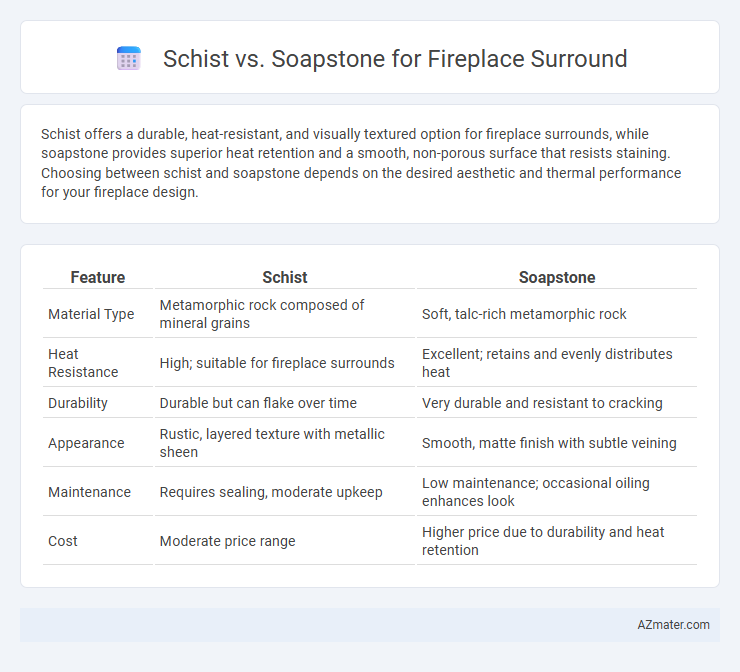Schist offers a durable, heat-resistant, and visually textured option for fireplace surrounds, while soapstone provides superior heat retention and a smooth, non-porous surface that resists staining. Choosing between schist and soapstone depends on the desired aesthetic and thermal performance for your fireplace design.
Table of Comparison
| Feature | Schist | Soapstone |
|---|---|---|
| Material Type | Metamorphic rock composed of mineral grains | Soft, talc-rich metamorphic rock |
| Heat Resistance | High; suitable for fireplace surrounds | Excellent; retains and evenly distributes heat |
| Durability | Durable but can flake over time | Very durable and resistant to cracking |
| Appearance | Rustic, layered texture with metallic sheen | Smooth, matte finish with subtle veining |
| Maintenance | Requires sealing, moderate upkeep | Low maintenance; occasional oiling enhances look |
| Cost | Moderate price range | Higher price due to durability and heat retention |
Introduction to Schist and Soapstone Fireplaces
Schist and soapstone are popular materials for fireplace surrounds due to their durability and unique aesthetics. Schist features a foliated texture with shiny mineral flakes, offering a rustic and natural look, while soapstone is prized for its smooth surface and excellent heat retention properties. Both materials provide functional and decorative benefits, making them ideal choices for enhancing fireplace design.
Composition and Geological Origins
Schist, a metamorphic rock rich in mica and quartz, originates from intense heat and pressure that realign its mineral grains into foliated layers, providing durability and natural shimmer for fireplace surrounds. Soapstone, composed primarily of talc with varying amounts of chlorite and magnesite, forms through the metamorphism of ultramafic rocks and offers exceptional heat retention and softness that allows easy carving. Understanding the distinct mineral composition and geological formation of both stones helps in selecting the best material for aesthetic appeal and thermal performance in fireplace surrounds.
Visual Appearance and Color Variations
Schist offers a striking, textured appearance with a natural, layered structure that enhances fireplace surrounds through its metallic flecks and varied color palette ranging from silvery grays to earthy browns. Soapstone features a smooth, matte surface with consistent coloration, typically found in shades of gray, green, and beige, providing a timeless, subtle elegance for fireplace designs. The choice between schist and soapstone depends on the desired aesthetic, with schist delivering bold visual interest and soapstone ensuring understated sophistication.
Heat Resistance and Thermal Properties
Schist offers excellent heat resistance and retains warmth effectively, making it suitable for fireplace surrounds that require durability under high temperatures. Soapstone is renowned for its superior thermal conductivity and heat retention, gradually releasing heat over time, which enhances energy efficiency in living spaces. Both materials withstand repeated heating and cooling cycles without cracking, but soapstone's dense structure provides a more consistent thermal performance.
Durability and Longevity
Schist offers exceptional durability for fireplace surrounds due to its tightly interlocked mineral grains, making it resistant to heat and wear over time. Soapstone, while softer and more susceptible to scratching, excels in heat retention and develops a unique patina that enhances its longevity with proper care. Both materials withstand high temperatures, but schist typically provides a longer-lasting, more robust option for heavy-use fireplace installations.
Maintenance and Cleaning Requirements
Schist fireplaces require sealing every 1-2 years to prevent staining and are best cleaned with a soft brush and mild detergent to avoid damaging the natural foliation. Soapstone is highly durable and heat-resistant, needing minimal maintenance beyond occasional wiping with a damp cloth and mild soap to remove soot and grime. Both materials are resistant to heat, but soapstone's non-porous surface makes it easier to clean and less prone to staining compared to the more porous schist.
Cost Comparison and Budget Considerations
Schist and soapstone are popular choices for fireplace surrounds, each differing significantly in cost and budget impact. Schist typically ranges from $15 to $30 per square foot, offering a more affordable and natural textured option compared to soapstone, which often costs between $50 and $100 per square foot due to its durability and heat resistance. Budget considerations should include installation expenses, as soapstone requires specialized labor, potentially increasing overall project costs, while schist's more straightforward installation helps reduce expenses.
Installation Process and Practicality
Schist offers a durable and heat-resistant option for fireplace surrounds, requiring professional installation due to its uneven surface and need for precise cutting. Soapstone, known for its smooth texture and ability to retain heat, allows for easier customization and can often be installed with less specialized labor. Both materials provide practical long-term benefits, but soapstone's lower maintenance and natural resistance to cracking make it a preferred choice for functional and aesthetic fireplace surrounds.
Design Flexibility and Aesthetic Appeal
Schist offers a rugged, natural texture with a shimmering surface that enhances fireplace surrounds through its unique, layered appearance and variety of color options, making it ideal for rustic or traditional designs. Soapstone provides a smooth, matte finish with subtle veining, delivering a sleek and modern aesthetic while offering exceptional design flexibility due to its ability to be carved and shaped easily for custom fireplace surrounds. Both materials excel in heat resistance, but schist's dynamic patterns cater to bold, statement pieces whereas soapstone's understated elegance suits minimalist and contemporary interiors.
Choosing the Best Stone for Your Fireplace Surround
Schist offers a durable and textured surface with natural shimmer, making it ideal for creating a rustic yet elegant fireplace surround that withstands high temperatures. Soapstone provides excellent heat retention and resistance to thermal shock, which ensures long-lasting performance and smooth, soft aesthetics for a cozy ambiance. Selecting the best stone depends on balancing Schist's rugged beauty and soapstone's superior heat conduction to match your fireplace's functional needs and design preferences.

Infographic: Schist vs Soapstone for Fireplace Surround
 azmater.com
azmater.com